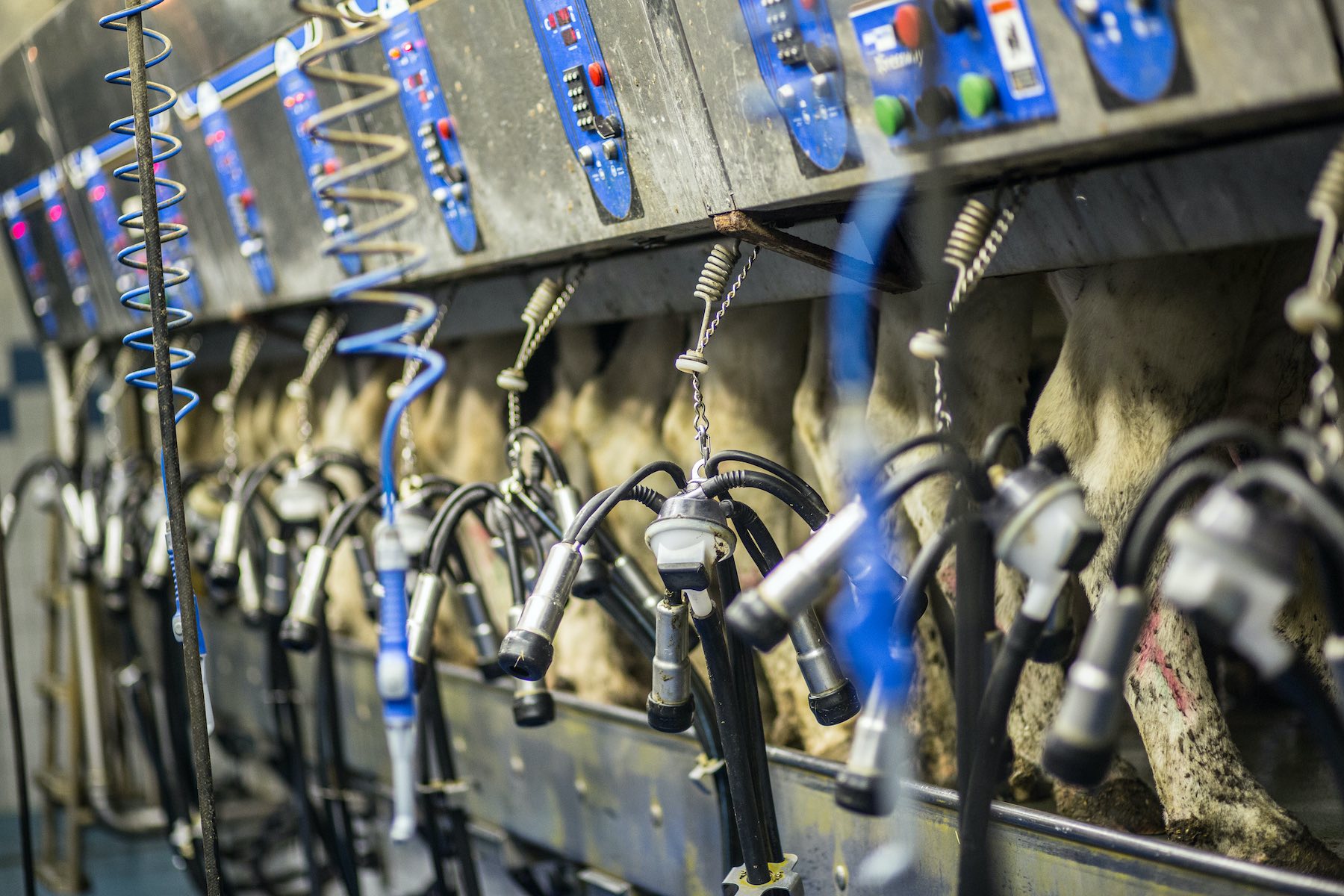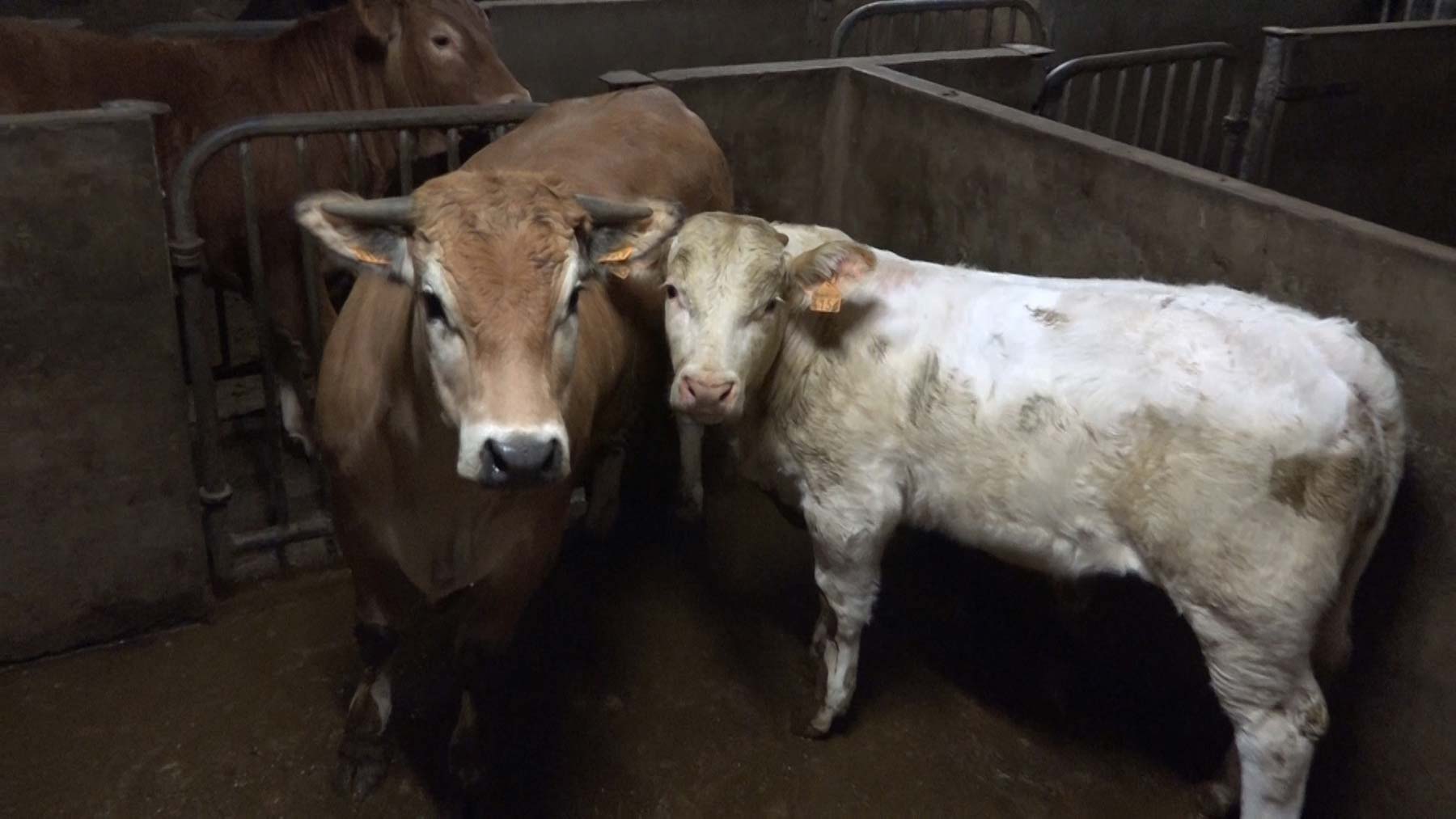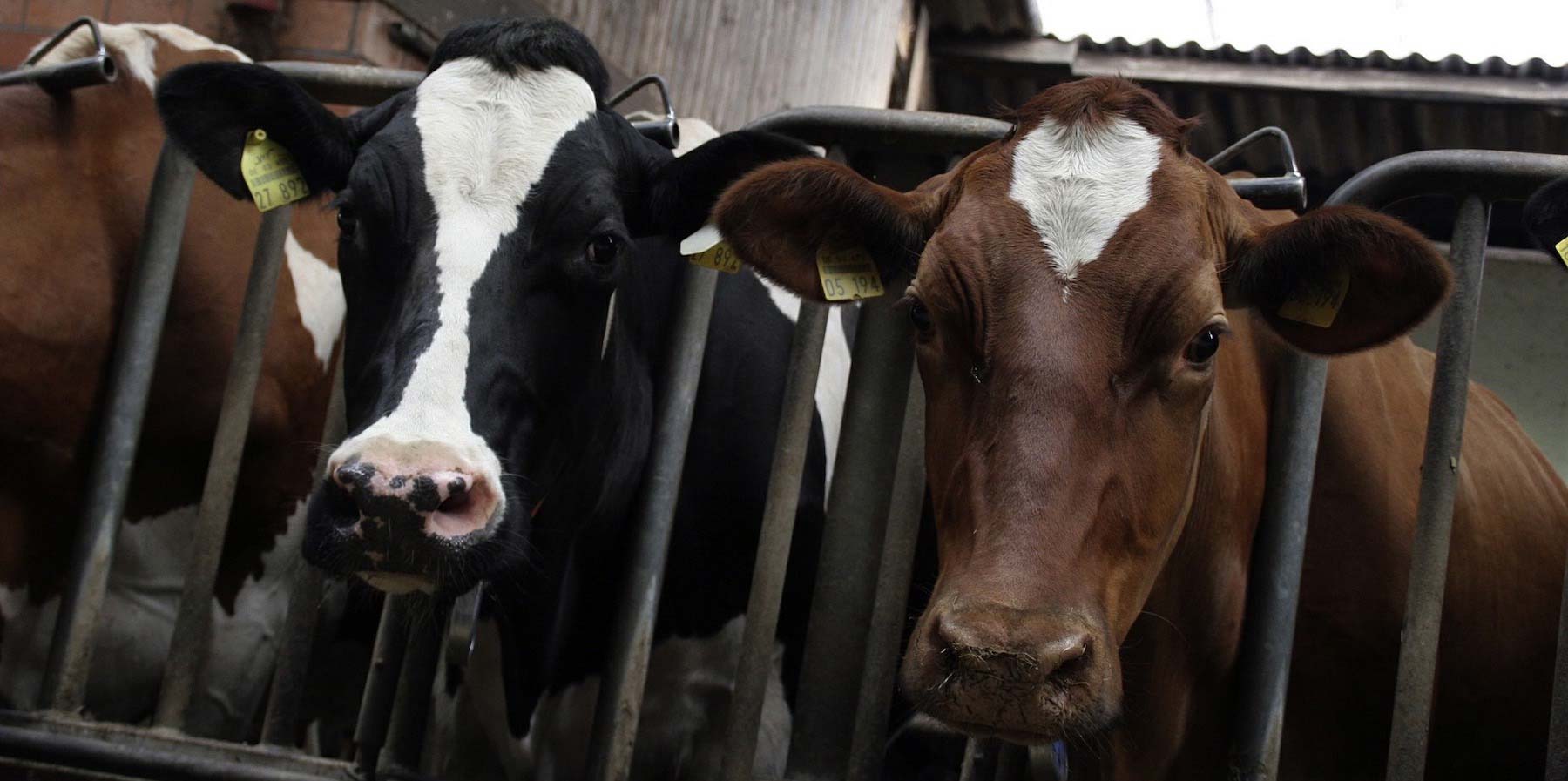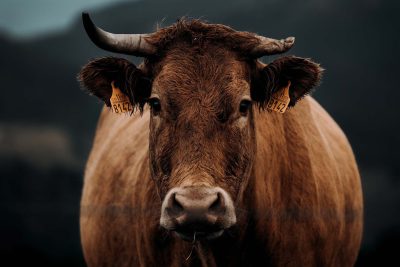Cows are among the most abused animals on earth. These gentle creatures thrive on social interaction and form close and long-lasting relationships with members of their herd. Semi-wild cattle groom and graze together, share food and coordinate their activities. For females, the closest and strongest bond they form is with their calf, and yet this bond is broken repeatedly on industrial farms, causing great distress to both mother and child.
What Percentage of Cows Are Factory Farmed?
Using data from the 2017 USDA Census of Agriculture, The Sentience Institute estimates that 70.4 percent of cows in the U.S. are factory farmed.
What Is Factory Farming?
This is the breeding, rearing and slaughtering of animals on an industrial scale. It’s a system that treats animals as if they were components in a factory rather than individuals who have emotional, physical and psychological needs, and can suffer. Factory farming is utterly ruthless. Animals’ needs are met only insofar as they help boost profits. Nothing else matters.
Why Is Factory Farming Bad?
It’s bad for animals as it steals from them a life worth living by denying them their natural behaviors. Cows cannot roam, graze, choose a mate and rear their young. Nothing is left to nature. Almost every action – from forced insemination to branding to removal of day-old calves – causes suffering and stress.
Factory farming is also bad for the environment. Animal agriculture is responsible for 14.5 percent of all human-generated greenhouse gas emissions, and as such is one of the leading drivers of climate breakdown.
It is bad for forests, too. Feeding farmed animals requires vast amounts of land because they need to eat far more calories than we get back in meat, milk and eggs. Currently, animal agriculture uses 83 percent of our farmland but gives us just 18 percent of our calories. What a waste! And this has consequences. In order to grow sufficient feed for these billions of hungry mouths, we need ever more land, and so rainforests and other precious habitats are destroyed. This is how factory farming is a key driver of deforestation.
When habitats are destroyed, wild animals are killed or driven out. Just since 1970, humanity has wiped out 60 percent of wild animal populations. Once again, animal agriculture is a key cause. Today, of all the mammals on Earth, 96 percent are humans and farmed animals, with just four percent wild mammals. If we want to protect wild spaces and the animals who live there, we must end animal agriculture, and we must start with the worst culprit – factory farming.
How Long Do Cows Live In Factory Farms?
Anything from an hour to ten years, depending on whether they are born into a meat or dairy farm, what sex they are, and what humans want from them.
The females used to breed and birth cows for beef are likely to live the longest, and will be slaughtered when their fertility declines, often around ten years of age, which is half their natural lifespan. Their offspring will be slaughtered for their meat usually before the age of three.
Female cows farmed for their milk must be kept almost constantly pregnant, since milk is made specifically for a baby. The mothers endure horrendous physical and emotional stress throughout their lives, and their bodies break down at around the age of six. If their calf is female, she may enter the dairy cycle alongside her mother and live a few more years; if male, he may be shot within hours of birth.

How Are Dairy Cows Farmed?
Female cows used for their milk production are kept incarcerated, often with no access to pasture, and may have inflicted on them a series of painful procedures including branding, eat-tagging and dehorning. Cows, like people, must be pregnant to produce milk so when they reach the age of fertility, they are artificially inseminated. Nine months later, their calf is born. Cows are caring, nurturing, loving mothers who want desperately to take care of their young. But on dairy farms, this is not allowed. The calves are taken from them – a powerful loss for both mother and young, who call and call for one another in vain. The reason? We cannot allow the baby to have one drop of the milk we want. And so the young are taken away, fed on a milk substitute and raised for veal or to join the dairy herd. Others may not be fed at all; they may simply be shot, their distraught mothers looking on.
What About Beef Factory Farming?
Many beef cows begin their lives on the range, foraging and fending for themselves but most are trucked to feedlot factory farms within their first year. These young animals may be branded, de-horned and castrated, all without pain relief. On the feedlot, thousands of animals are crowded into pens where there is nothing to do and nowhere for these roaming animals to go. After all, why would farmers allow them to burn off food unnecessarily when every pound of grain costs them money? And that is their whole lives, standing in extreme weathers, day after day, month after month, until the truck arrives that will take them to the slaughterhouse.
What Happens To Veal Calves?
Calves raised for veal live their whole short lives inside tiny wooden crates that severely restrict movement. They are fed a milk substitute which is deliberately deficient in iron and fiber so as to keep the animals anaemic and their flesh pale. They feel weak and exhausted but some people think that the taste of their meat trumps the animals’ wellbeing.

These young cows, their muscles atrophied, are typically slaughtered at around 18 weeks of age, although some may be less than three weeks old. Known as “bob” veal, these babies’ bodies are turned into low-grade products like hot dogs and soup.
Animal Cruelty In Factory Farms
Not only do cows suffer from the factory farm regime, they suffer additionally at the hands of farm workers. In 2019, Animal Recovery Mission filmed calves on a dairy farm being kicked, dragged, and violently thrown to the ground, while their desperate mothers called and called until they became hoarse. Those who survived were put into calf hutches where the young, vulnerable animals could be seen struggling for breath as they succumbed to dehydration and malnutrition in temperatures that soared to 43C.
The investigator wrote that they’d seen employees “punching, kicking, and stabbing cows, sometimes hitting their udders with the milking claws or shoving them with metal tubes and broomsticks. When cows in the milking line would not cooperate, frustrated employees would bend and break the cows’ tail bones as punishment. On a daily basis, cows with infected eyes, broken bleeding tails, infected udders and afterbirth placentas hanging out from their bodies were seen being forced on the rotary system.”
This is not an isolated incident. Investigations in Mexico, the UK, India, Australia, Canada and Italy all show similar abuse, while the number of investigations in the US continues to rise.
Cows Are Fed Only To Increase Productivity
In a factory system, there is a very simple equation: maximum output for minimum input = largest profits. And so every corner is cut to get the most amount of meat or milk with the least financial outlay. Cows are prevented from moving as that is a waste of energy! They are fed cheap artificial feed, no matter if it is not great for their digestive systems. They are impregnated, birthed and slaughtered all at pre-ordained times to ensure maximum profits and a smooth-running process. If milk and meat could be obtained without feeding cows, you know that this would happen. As it is, the calculation is carefully made, and they are fed the absolute minimum needed to get the maximum output.
Crowded Lots
One beef farmer said of feedlot conditions: “Cattle feedlots have been compared to crowded medieval cities with open sewers and choking air – the difference being that feedlots have antibiotics to keep the occupants alive.”
With thousands of animals in one place, the waste poisons the earth and air, the ground can become sodden causing hoof problems, and diseases can pass more easily from animal to animal.
Forced Reproduction
Cows are artificially inseminated to make sure they get pregnant on a day that ensures the optimal production of calves and milk. This process is done with one hand in the cow’s anus to manipulate her cervix while the other inserts a straw of semen into her vagina. There is nothing natural about animal farming, not even reproduction.
Forced To Stand And Sleep On Dung
Cows in feedlots produce between one and two tons of manure per animal per year, and the areas don’t get cleaned out all that often. In most feedlots, there is nowhere for animals to get away from the waste. They have no choice but to stand in it and sleep in it.
Prevented From Grazing
Cows are perfectly designed for grazing and have four stomach compartments to allow them to digest that fibrous grass, but on feedlots, they don’t even see a blade of it. One farmer, whose testimony was later removed from the site, said that the grain sickens them but, because of the antibiotics they are fed, along with the “tractor-trailer load” of baking soda to counteract the acid, it usually does not result in their deaths.
Researchers from the College of Veterinary Medicine at Kansas State University wrote: “Mortality from digestive diseases in feedlot cattle is second only to that from respiratory diseases. Acidosis is a major digestive disorder and is likely to continue because of ongoing attempts to improve the efficiency of beef production by feeding more grain and less roughage.”
In other words, it is cheaper to feed them on grains that kill a large number than to let them live and graze as they should.
Sick Cows Are Left To Die
Not all cows survive these appalling conditions. Veterinary treatment isn’t cheap and so a judgment is made: is this cow worth treating? If he or she is very ill or very young, the answer may be no, in which case, they will simply be left to suffer to death.
Transportation
Cows may be transported several times during their lifetimes: from the range to an auction to a feedlot and then to slaughter. Crammed onto trucks, they may be transported for days without food, water, or rest. Many collapse and die in the heat. In the cold, cows can sometimes freeze to the sides of the truck. Unsurprisingly, many do not survive.

Develop Various Diseases
Cows can suffer a whole array of diseases, some of which can also pass to people. These include anthrax, E.coli, giardiasis, leptospirosis and rabies. Most commonly, they suffer respiratory diseases, lameness, mastitis and diarrhea. The antibiotics they are given routinely to try to keep them alive contribute to antibiotic-resistant bacteria that kill people.
Extreme Stress
Cows suffer severe physical and emotional stress as a result of their treatment on farms. Confinement, unnatural diet, repeated forced pregnancies and the loss of their young, mutilations, transportation, extremes of temperature and exposure to pathogens cause unconscionable stress for these sensitive animals.
Lameness
Lameness is commonplace in dairy herds. It is caused by infections such as laminitis, and compounded by poor nutrition and long periods standing on hard floors. John Webster, Emeritus Professor at the University of Bristol in the UK likened the pain to us having our fingernails crushed in a door, and then having to stand on those fingertips for hours.
Mastitis
Mastitis is a bacterial infection of the udder that causes painful swelling or hardening. It is frequently attributed to unhygienic, cramped, and poorly ventilated living conditions, while the trauma caused by milking machines to the sensitive teat tissues is also a predisposing factor.
Milk from infected cows has a much higher somatic cell count. When a cow is infected, more than 90 percent of the somatic cells in her milk are ‘neutrophils’, the inflammatory immune cells that form pus. With mastitis so prevalent in dairy cows, there is no way to avoid it. According to Dr. Michael Greger, the average cup of milk in the United States contains up to one drop of pus.
Reproduction Problems
Cows are pushed to their biological limits and beyond. Lameness, sadness, exposure to pathogens and exhaustion all take their toll. They may miscarry their young or be unable to get pregnant. An infertile cow is of no economic use, and these cows are dispassionately sent to slaughter. Infertility is one of the main reasons why cows used for milk are ‘culled’.
Genetic Mutations Of Dairy Cows
The drive for greater milk yield also has an impact on fertility. Scientists have found a genetic correlation between increased yield and decreased fertility. In short, the more we ask of them, the more their bodies break down. Our drive to breed greater productivity into cows comes at a very high price for them. And perhaps for us, too …
In the US, it is legal for farms to inject cows with Bovine Growth Hormone to get them to produce even more milk. Its use is banned in the European Union, Canada and elsewhere due to concerns about its association with cancer.
How Can It Affect The Environment?
Ruminants release climate-destroying gases as part of their natural digestive processes, and also in their manure. This is not a problem with bovines living in the wild but it is a major problem now we have bred almost one billion into existence inside factory farms. Of all animal products, beef causes the most damage by far. It is so bad that even beef from a nearby farm is still six times worse for the planet than fruit transported from the other side of the world. Oxford University researchers found that even the least sustainable plant milk is still better for the planet than the most sustainable cows’ milk.
The massive amounts of waste produced by cows is another way that animal agriculture is destroying the planet. There is so much of it that it cannot be sprayed onto the land but is stored in giant ‘lagoons’ but it leaches out and gets into waterways where it pollutes and poisons. It can kill rivers and create ocean dead zones by causing algal blooms that take all the oxygen out of the water. Nothing can survive.
How Are Cows Killed In Factory Farms?
Sick cows may be killed on factory farms using a gun or a captive bolt. Cows whose bodies end up being eaten—which includes the bodies of dairy cows—will be killed at a slaughterhouse.
There, after an agonising journey, the animals will be unloaded, directed through a ‘race’, often by using severe force against these gentle creatures. One at a time, they will be stunned with a retractable bolt aimed into their brains, then hoisted by a back leg and their throats are cut.
Factory Farmed Cows Statistics
- There are over 9 million dairy cows in the US with each cow producing up to 100 pounds of milk per day
- Dairy cows are forced to have a calf every 12 months to keep the milk flowing
- Half million male calves are raised and slaughtered for veal each year – these are babies, kept chained, weak and anaemic, after being taken from their mothers
- The crates they are kept in are typically no more than 2.5 feet wide.
- A standard beef slaughterhouse can slaughter up to 400 animals per hour
- In 2019, 33 million cows were slaughtered for beef in the United States

Conclusion
There is no doubt at all that cows suffer terribly because we want what they have: their young, their bodies, or their milk. And it seems there is no suffering too terrible to inflict on them. We know that a mother separated from her young is one of the worst fates to befall anyone, and yet such emotional torture is routine for cows on today’s industrial dairy farms.
It doesn’t have to be this way. We each have the capacity for compassion and our role in preventing this suffering is simple. We just have to make more compassionate choices.



